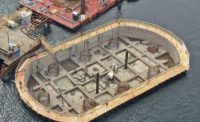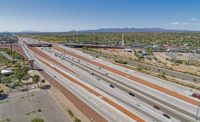A July 2013 landslide removed approximately a half-mile section of US 89 south of Page, Ariz., forcing the governor to declare an emergency and implement a temporary detour along Navajo Route 20. ADOT awarded the $22.3-million-plus contract in July 2014, and work immediately began on the severe slope in a remote location on a road essential to the economic vitality of Northern Arizona.
“The impact of the road closure was felt by local residents, tourists, businesses, schools, transient commerce and area emergency services,” says Audra E. Merrick, ADOT’s Flagstaff district engineer. “Getting the roadway back open and ensuring the problem wouldn’t happen again was major factor in the project.”
The general contractor relocated the highway 60 ft east into the cut. The company demolished the damaged roadway, excavated 1 million cu yd of gravel and rock, provided water, supervised the stormwater pollution prevention plan (SWPPP), installed storm drainpipe and performed related work.
Material from the cut was transported to the base of the landslide to construct a rockfill buttress to help alleviate downward pressures on the landslide area. The scope also included blasting, placement of aggregate base, asphaltic concrete paving, constructing a maintenance access road for the buttress and guardrail installation.
Despite performing 73 blasts and hauling 47,000 loads on tight, steep roads in an unstable slide area, the project had no lost-time incidents.
Safety measures included left-handed construction traffic per MSHA rules on an OSHA site, extensive equipment training, seismic monitoring for blasts, the use of inclinometers and identifying smaller vehicles with 10-ft-high warning flags.
“Every morning there was a mass safety meeting and every afternoon a meeting in the excavation to discuss production,” explains Matt Trembly, senior project manager at FNF Construction Inc. “The entire project team attended, and we discussed the day’s operations, safety concerns, job hazard analysis and also performed stretch and flex.”
In addition, “everybody who came on to the worksite had to log in when they arrived and log out when they departed to ensure an accurate head count in the event of any unexpected landslide activity,” Merrick says.
Because of visibility concerns and the amount of material rolling over the edge of the excavation, a spotter was placed along the haul road and a flagger at each end of the jobsite, with radio contact to all appropriate personnel to coordinate the trucks.
Access for emergency vehicles was critical. “We asked the emergency vehicles to use their sirens when entering the project,” Trembly says. As a result, emergency vehicles were never delayed.
Crews completed construction in March, 30 days ahead of schedule. “This landslide changed many lives, and getting the road repaired and open allowed these people to resume their lives,” Trembly says.
US 89 Slide Reconstruction
Page, Ariz.
Key Players
Owner Arizona Dept. of Transportation
General Contractor FNF Construction
Lead Design Firm AECOM
Geotechnical Design Firm Kleinfelder
Subcontractors Rummel, Terracon, Wesco








Post a comment to this article
Report Abusive Comment